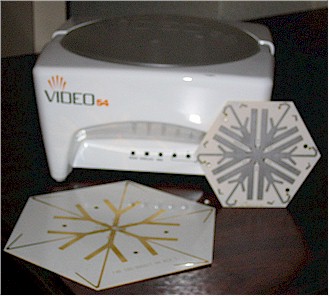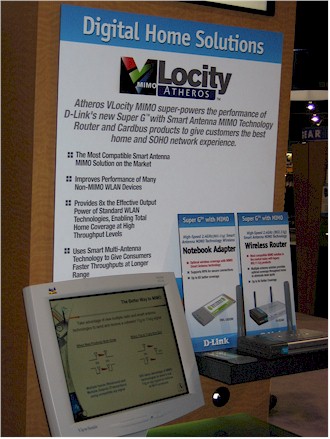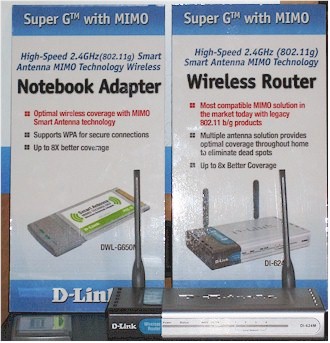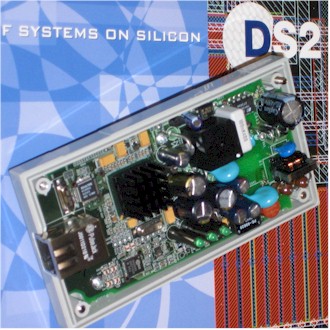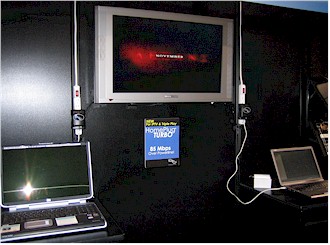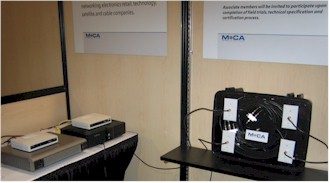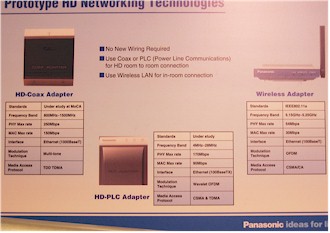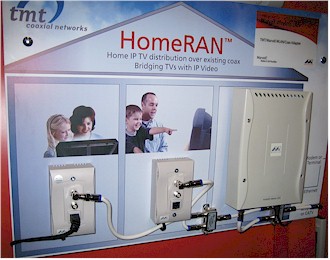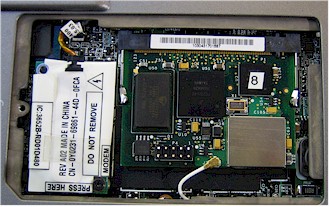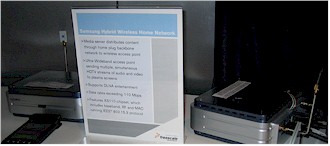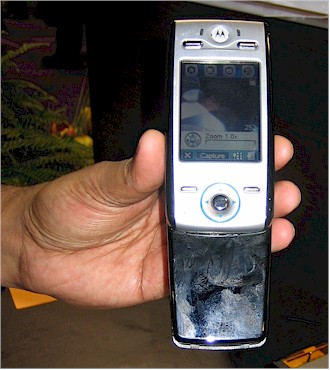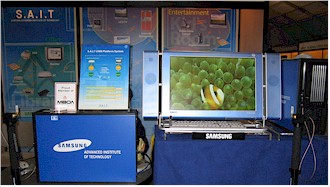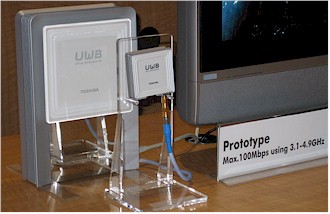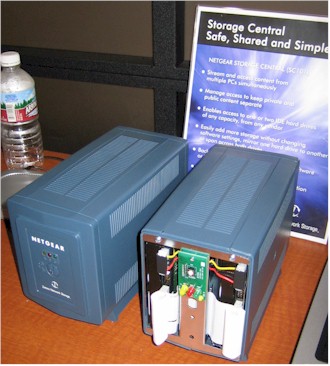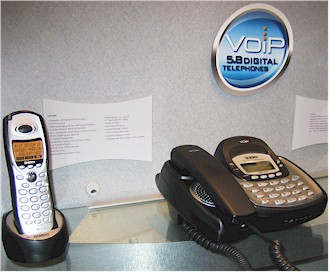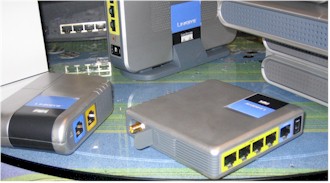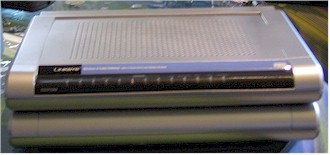Introduction
I’ve made my rounds and poked and prodded and am ready to report my findings from last week’s Consumer Electronics Show. One of my missions was to sort out fact from fiction for the newer home multimedia networking alternatives of HomePlug AV, UWB, MoCA and even MIMO. I can’t say that I succeeded in finding truth in all cases, but I think I at least got a better sense of where things stand.
For the bottom-line oriented among you, my conclusion is that that you just might see home multimedia networking alternatives based on a ratified MoCA (coax) standard in time for this coming Christmas‘ buying season. But I’m skeptical as to whether the HomePlug Alliance will be able to get HomePlug AV to market this year. As you’ll see in the report, however, this doesn’t mean that high-speed networking products that use powerline technology won’t also be “in the channel” – probably long before Christmas 2005.
The Ultra Wideband (UWB) story is that it’s unlikely that we’ll see UWB products for short-range connection of HD (or even standard resolution) flat-screen TVs this year. But it’s definitely a possibility that you’ll see the first “Wireless USB” retail products based on the OFDM flavor of UWB currently being developed by members of the MBOA.
I’d also be very surprised if any of these newer technologies were built into the gorgeous (and increasingly larger) plasma, LCD, LCOS, DLP, etc. displays, although you may see some of them embedded into “media servers”, “AV centers” or networked players of various flavors. As one of my contacts put it, any manufacturer would be crazy to risk having a multi-thousand dollar piece of consumer electronics be returned, or risk even slight customer dissatisfaction because of a $10 networking module, no matter how sexy the technology used!
On to the details…
MIMO multiplies
I spent some quality time in both Atheros and Video54‘s rooms to get the details on their MIMO approaches. One of the things I learned is that I’ve been confused in the number of antennas and radios that the three currently-announced MIMO approaches use. So to set the record straight, here’s a handy table:
| Manufacturer |
Radios
|
Antennas |
Channels
|
| Airgo |
3
|
3 |
1
|
| Video54 |
1
|
Varies – 7 in NETGEAR product |
1
|
| Atheros |
2
|
4 (2 per radio) |
2
|
|
Table 1: MIMO details
|
|||
You’ll note from the table that Video54 uses only one radio, but has the most antennas, which are connected via software-controlled RF combiners. The company’s “secret sauce” lies in the design of those antennas and the signal processing that constantly controls which of them are used for transmit and receive. Video54 says their MIMO implementation provides up to 20dB of signal gain.
You can see a couple of the printed-circuit antenna designs in the picture below, which also shows the Video54 reference AP design. Note that this is not necessarily what the NETGEAR product will look like and the Video54 folks properly directed me to NETGEAR for all those details (which I didn’t get).
Video54 MIMO Reference design with antenna samples
One of the cool features that the Video54 design team came up with were LEDs near each antenna. Originally added as a debugging feature and each antenna’s LED is lit only when it is used for transmit or receive. When I saw how the lights behaved while the obligatory demo video was being streamed, I thought that it so effectively showed how their MIMO implementation worked that I took a little video.

Video54 MIMO in action
You can click here to download the AVI clip (about 1MB) and see Video54’s MIMO doing its thing. Note again, that these LED’s are part of the Video54 reference design and may not necessarily appear in retail products.
More MIMO
My Atheros visit didn’t involve any light shows, but instead got me the details on their VLocity MIMO. Their approach – which is along the lines of the TGn Sync proposal – uses two radios, with each radio having two antennas. But unlike both Airgo and Video54, which keep their MIMO activities confined to one channel, each Atheros radio uses a different channel.
I would think this could leave them open for attack by competitors for being spectrum hogs. But if the VLocity implementation really is close to the TGn Sync proposal, there should be a mode using a “legacy-compatible” 20Mhz channel width with reduced throughput.
So the VLocity approach bullet items are: dual channel; beam forming (power steering to antennas); and receive combining. They said this combination gives them about 10dB of path gain which should result in an improved throughput vs. range curve, i.e. better speeds at longer ranges. They also said that VLocity provides between 3 and 5dB of gain if only one end (AP or STA) is VLocity-enabled.
You can get some of those bullets by looking at the shot of the poster I found in D-Link’s booth, which is where Atheros sent me to look into getting review product.
The Atheros VLocity pitch – D-Link style
But when I visited D-Link’s booth, they didn’t even mention the product and I forgot to ask while I was being given the tour. When I later returned to inquire about when I could get the product for review, I was told that review units weren’t being sent to anyone just yet.
D-Link MIMO products
So while Atheros says that their chipsets are shipping in volume, it looks like their first VLocity customer isn’t quite ready to get the product out into the market.
Finally, since the word on the street was that Broadcom would be announcing its MIMO contender sometime in the next few months, I asked them about it during my booth visit, which centered on demos of their Bluetooth solutions and SecureEasySetup [related article]. But the only thing that Jeff Abramowitz, Broadcom’s senior director of wireless LAN marketing would say about its rumored MIMO offering is that they would “aggressively pursue the sweet spot of the market”. Mr. Abramowitz sees the components of this “sweet spot” as having higher speed and greater range as well as being 802.11n upgradable and attractively priced.
HomePlug
I came away from my multiple visits to the HomePlug booth area with the impression that there is definite trouble in HomePlug AV city. I heard everything from the assertion that HomePlug AV will be DOA, to the fact that DS2’s 200Mbps solution (pictured below) is not HomePlug 1.0 compliant.
DS2 200Mbps Powerline reference design
Panasonic’s announcement that it is joining with Mitsubishi and Sony to explore their own powerline networking solution doesn’t cast a positive light on the Alliance’s efforts either. Nor does the formation of a new powerline networking industry group, the UPA (Universal Powerline Association), bode well for keeping everyone under the HomePlug tent.
The other evidence that AV may be further off than the Alliance would have us believe is Intellon‘s (through its partner Asoka USA) touting of its 85Mbps HomePlug Turbo design (pictured below) [related story]. It begs the question of if AV is so close, why would a company commit resources and risk the Alliance’s wrath to get a lower-performance solution to market?
Asoka USA HomePlug Turbo
On the other hand, DS2 and Corinex‘s push of a 200Mbps powerline product into the market could be seen as a “pre-AV” strategy, which, if successful, could get Alliance members to stop their feuding and nail the spec before those companies walk away with the market. While all this makes for a great soap opera, the players in this space should realize that the enemy is not each other, but the other multimedia networking technology competitors!
Coax
Things seem to be a little rosier in the MoCA camp, with most demos using either Entropic‘s reference module (pictured below) or Entropic-based designs. Entropic has been shipping its reference design modules to its partners and potential customers for field trials for some time and say results are very encouraging. But Entropic doesn’t seem to be confident enough yet in its design to submit it to reviewers for testing, since I received a “we need to discuss this further” response to my request for review product.
MoCA demo with Entropic modules
I was told by multiple sources that the MoCA spec is still on track for end of Q1 blessing. But I didn’t get a definite answer on when MoCA-compliant products would be available for review, although the frequently-heard Christmas 2005 timeframe was floated as a possibility for retail MoCA-based products.
I was a bit confused as to whether Panasonic was still in the MoCA camp, especially given the announcement on its powerline networking strategy. But the poster in the HD (High Definition) Networking area of the Panasonic booth (shown below) and conversations with both Panasonic and MoCA folks assured me that everyone showing coax-based networking was still in the MoCA camp.
Panasonic – MoCA Yes, HomePlug AV No
Everyone, that is, except for TMT Coaxial Networks, whose HomeRAN coax system is not MoCA compliant. Its product, which is already deployed in hotels and similar installations has a 60Mbps raw data rate with usable bandwidth in the mid-50Mbps range.
tmt HomeRAN Coax
The same HomeRAN display you see above, but with a D-Link sticker on it was in D-Link’s booth, but they didn’t seem interested in talking about it at all. I was also confused when an Entropic rep pointed me to D-Link as a possible source for MoCA-based consumer product, since they were instead showing the non-MoCA TMT product. (An Entropic rep later told me via email that this was due to a last minute mixup and that D-Link did indeed intend to have MoCA-based product.)
UWB
There are still definitely two UWB camps fighting for mind and market share. The UWB Forum backs Direct Sequence Ultra-Wideband (DS-UWB) technology originally developed by startup ExtremeSprectrum, then bought by Motorola’s Semiconductor Products Sector, and since spun off as Freescale Semiconductor. The competing MBOA / WiMedia camp endorses the MB-OFDM UWB flavor that is based on work done by TI and endorsed by Intel and many other companies.
I got the sense that the two camps are heading in different directions with the UWB Forum concentrating on streaming media applications and the MBOA / WiMedia group getting behind a Wireless USB data-transfer-focused push to market. This isn’t to say that either camp will permanently maintain that focus, but just that these applications are where their first efforts lie.
To help you get a sense for the technologies’ development status I grabbed some pictures during my booth visits. The shot below shows one of the mini-PCI modules from either Taiwan ODM’s Global Sun or Gemtek in one of the notebooks used in the various demos in Freescale’s booth.
Freescale DS-UWB mini-PCI
The booth also had a streaming video demo using a combination of Intellon’s HomePlug AV implementation and Freescale’s DS-UWB using a Samsung media server (with Samsung mini-PCI card).
Freescale / Samsung DS-UWB
The booth did have a data transfer demo using the modified Motorola camera phone shown below. That application may be a little ways off, since the modified phone obviously uses a mini-PCI card.
Freescale-based DS-UWB cameraphone
More UWB
The MBOA / WiMedia group had an area with over a dozen affilitated companies. Samsung was the only company to have a toe in each group, since their Advanced Institute of Technology group had an HD streaming demo going and people present to talk up Samsung’s MBOA work.
Samsung MBOA demo
Samsung MBOA poster
I also got another close-up shot of Toshiba‘s MBOA-based module at the UWB technology display in their booth.
Toshiba MBOA module
While I didn’t see a demo, the time I spent in Texas Instruments‘ room at the Hilton had me convinced that they are going all-out to have real Wireless USB products in the market this year. Their focus is on high speed data transfer for mobile devices such as cameras and camcorders and portable media players.
I don’t know where TI is on getting their hardware small enough to fit into these devices or into the flash-key-sized dongles they said would be used to add Wireless USB to existing PCs. The only hardware visible in the room was a setup similar to that shown in the “Samsung MBOA demo” photo above, and I didn’t have time to probe further.
Digital Multimedia Products
There were a number of multimedia players of various flavors and configurations announced at the show, and I came nowhere near covering them all. Since my focus was with the networking product vendors at the show, that’s mostly what I’ll report on here.
Buffalo Technology announced its LinkTheater High Definition Wireless Media Player (PC-P3WG/DVD). Its main claims to fame are its support of WMV, WMV HD, DivX, DivX HD and Xvid formats and playback and up-conversion to 720p/1080i from its built-in Progressive Scan DVD player.

Buffalo Technology Link Theatre
It also functions as a media adapter with 10/100 Ethernet and 802.11g wireless network connections and has a USB 2.0 port for media playback from digital cameras, USB flash drives, card readers or external hard drives. Other features are Buffalo’s AOSS one-touch secure wireless configuration, composite, S-video and Component Video outputs and 5.1 channel Dolby Sound and DTS. All this for $349 when it goes on sale in February.
My first trip to D-Link’s booth in a long time gave them the opportunity to pitch the new additions to their MediaLounge line,
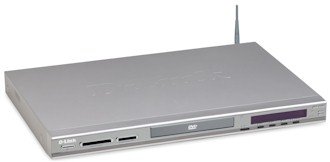
D-Link DSM-320RD Wireless Media Player with DVD and Flash Card Reader
The DSM-320RD shown above is basically their DSM-320 with a progressive-scan DVD player and flash card reader built in. It doesn’t support HD and will be available in March for $249 list.
Next out in “early Q2” should be the DSM-5208R Wireless Media Server. This one will support WMV-HD as well as other formats that haven’t been finalized. It will have a rather small 80GB internal hard drive and 5-in-1 card reader and USB 2.0 port to support attachment of external drives. No pricing has been set.
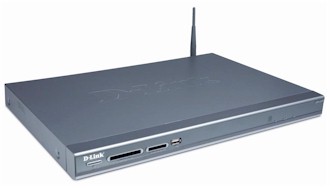
D-Link DSM-5208R Wireless Media Server
Further out in “Q3” is the DSM-520 which is essentially the replacement for the DSM-230. It will be a high definition media player that includes upconversion with a target list of $249.
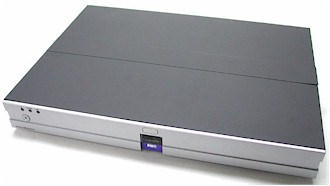
Linksys WMLV54G Wireless-G Media Link
My visit to Linksys also included a view of their WMLV54G Wireless-G Media Link [related story], which gives them a media player that doesn’t depend on Microsoft’s Windows Media server and can come in at a lower price point since it doesn’t have to support Windows Media’s rather hunky processing requirements.
NETGEAR had their recently announced MP115 (which was actually shown at last year’s CES!) on display.
By the way, I saw no sign of Linksys’ DVD Player with Wireless-G Media Link that they announced at last year’s CES, but forgot to ask them about it.
Networked Storage
It turns out that NETGEAR was showing a prototype of its SC101 Storage Central NAS box that’s based on Zetera‘s SAN-for-the-masses technology. The conversation I had with the Zetera rep. manning the display in NETGEAR’s booth confirmed that the target application for the product is handling multiple multimedia streams (especially High Definition). But he also emphasized the data security features (mirroring) and ability to easily expand storage due to the IP-based nature of Zetera’s approach.
NETGEAR SC101 Storage Center prototype
I also found out that NETGEAR intends to ship the SC101 without drives, thus avoiding getting involved in messy hard drive inventory management and also giving the company an opportunity to partner with drive manufacturers to offer attractive drive-bundling deals. I was also told the box will be capable of 12MBytes/sec sustained read / write.
Availabiltity is supposed to be “early Q2” and although pricing is still being set, I got the sense that the entry price point with about 200 – 300GB of drives loaded is going to be somewhere in the $300 – $400 range.
Tritton Technologies didn’t have a booth or suite, but its nomadic demo team showed me their current wireless TRI-WHD NAS offering which is getting a capacity bump and price adjustment. The entry-level model is getting a capacity bump from 120 to 160GB and staying at $349 list. But the 200GB version is getting repriced to $399 from its current $499 list.
 They also put a sample of their Simple NAS (pictured left) that will be out next month. It’s in a package that’s similar in size and look to their direct-attached drives and will come in 160, 200 and 250GB sizes that will be aggressively priced at $199, $229 and $299 respectively. They’ll also offer the box sans-drive for only $89 so that those of us with spare 3.5in IDE drives lying around can put them to use.
They also put a sample of their Simple NAS (pictured left) that will be out next month. It’s in a package that’s similar in size and look to their direct-attached drives and will come in 160, 200 and 250GB sizes that will be aggressively priced at $199, $229 and $299 respectively. They’ll also offer the box sans-drive for only $89 so that those of us with spare 3.5in IDE drives lying around can put them to use.
The Simple NAS name struck me as a bit odd, since its feature set will be very similar to that of its bigger TRI-WHD sibling – except without the wireless. Even though it’s priced similarly to the ASUS WL-HDD 2.5, which is also a BYO drive box, the Simple NAS’ use of 3.5 inch drives may outweigh its lack of the wireless capability that the ASUS product has.
By the way, I never made it to either the Iomega or Maxtor rooms to look at their NAS offerings since both were (slightly) old news, but I expect to have both the NAS 100d and Shared Storage in for review shortly.
VoIP
Most of the VoIP vendors were over in the Innovation tent, with the usual suspects represented. Packet8 was showing its Video Phone and Pulver Innovations and Free World Dialup had pods too. I almost missed FWD’s announcement that their free pulver.Communicator Skype-like application now interoperates with Skype. Wise move since if you can’t beat ’em, joining is at least a survival strategy (for the application, not FWD, which is doing pretty nicely, thank you).
Speaking of Skype, while at Actiontec‘s demo suite (more later) I saw their newish Internet Phone Wizard with Skype. This $70 or so box lets you use any cordless or wired analog phone with Skype. I liked that it powers itself of the USB port of the computer that it’s attached to, but wish it wasn’t limited to Win XP and 2000.
I dropped by Vonage‘s booth to get an in-person peek at the wireless VoIP phone products they announced in advance of the show, but never made it over to VTech’s offsite stand to see the Skype cordless phone which was also announced.
I did manage to swing by Uniden to see the UIP1868 VoIP Phone and DTA 200 Digital Telephone Adapter that they introduced.
Uniden UIP1868 VoIP Phone
The UIP1868 is a 5.8GHz digital expandable cordless phone with built-in VoIP adapter, expandable up to ten handsets and the DTA 200 suports VoIP calling on two telephone lines and features Caller ID, Call Waiting and 3-Way Calling. Definitely not the sexiest design around, but probably perfect for the small office market Uniden is targeting with the product.
Good Ol’ Networking
While multimedia products got most of the networking love at CES, it’s still straight networking products that pay the bills for most consumer networking vendors and a few products were announced in that category.
Actiontec showed me its announced-at-show 54 Mbps Wireless Multiport Print Server and 54 Mbps Wireless Game Adapter. The Game Adapter can bridge multiple clients and work with any 802.11b/g AP or wireless router (WDS not required) and supports WEP 64 / 128 encryption, but not WPA. It is available now at $129.99 suggested list.
The print server has two USB 1.1 and one parallel port and can support printing to all ports simultaneously. The server supports Windows-based printing as well as MAC OS X-based printing for PostScript printers, 64- and 128-bit WEP encryption, Internet Printing Protocol (IPP), and both Infrastructure and Ad-Hoc mode connection. It’s due to ship the end of this month at $149 suggested list.
My visit to the Linksys demo suite yielded a few products that will be announced in the coming months. Pictured below are a travel router on the left and mini 802.11g router on the right. The travel router is very Airport Express-y with a built-in power supply and pop-out US plug, but sadly, no built-in streaming audio adapter.
Linksys mini routers
The WRT54GC mini-router also has pop-out surprises of its own – an RP-SMA external antenna connector that you can see in the picture, and a swivel-out stand in case you like your routers vertical. Pricing and delivery have not been set for either product and the travel router doesn’t even have a product number yet.
Other wireless routers introduced at the show that I’ve previously covered include the U.S. Robotics “MAXg” extended-range line, Belkin dual-band and ZyXEL G+ (based on Broadcom’s Afterburner).
Next item to report is the first routers I’ve seen with built-in battery backup. Linksys also showed me the first of its new line of cable modems with built-in VoIP ATAs (Analog Telephone Adapters). The will be sold to cable companies only so that guys like Vonage and other PSTN-based VoIP providers don’t have all the fun.
Linksys VoIP, Battery backup combo cable modem
The first three models in the line-up – which features the new packaging you see in the photo above (sorry for the fuzzy pix) – include two models with battery backup, one with built-in 802.11g router and the other without, and a wireless version with no battery backup. The internal VoIP ATA supports both SIP and MGCP, which are the two most widely-used VoIP management protocols.
I also happened to spy similar, though not as attractively packaged, products over at Motorola‘s booth. The SBV5220 Voice Enabled Cable Modem with battery backup is shipping now and its removable NiMH battery provides enough poop for 8 hours of talk or 12 hours of standby time. Its built-in VoIP ATA supports both MGCP and SIP for two lines.
Also available is the SURFboard SBV5120 Voice over IP Cable Modem, essentially the same as the SBV5220 but without battery backup. Finally, coming in March is the VT2550 which is an Ethernet WAN router with two analog phone VoIP ports plus a PSTN port.
Other stuff
Finally, I ran across a couple of other networking products worthy of note. The first is the new silex technology SX-1000U USB Device Server. Similar in concept to KeySpan’s USB Server, the SX-1000U has only one USB 2.0 port (vs. the KeySpan’s four USB 1.1 ports) but can attach to a user-supplied USB hub to handle up to 15 USB devices. silex also told me that the SX-1000U supports more devices (“nearly all” is the way their promo material says it) including printers, scanners, storage devices, electronic whiteboards, digital cameras and even MP3 audio players. It’s available now for $99 suggested list.
Another product that caught my idea among the pods in the Innovations Plus tent was PepLink’s MANGA (Managed Adaptive Network Gateway). Intended for individuals or small companies who want to develop open source based networking products, MANGA comes in a number of configurations that include different numbers of USB and 10/100 Ethernet ports and mini-PCI slots. While not cheap (around $400 in single pieces) each product comes complete with an SDK and enclosure. The company also makes a smaller product called WiNTI (Wireless Network Terminator Indoor) – intended for wireless ISP CPE.
And finally, while cruising the booths of Taiwanese vendors in the International Gateway area, I came across Suresafe Technology‘s booth with, among other things, its assortment of cellular jamming devices.
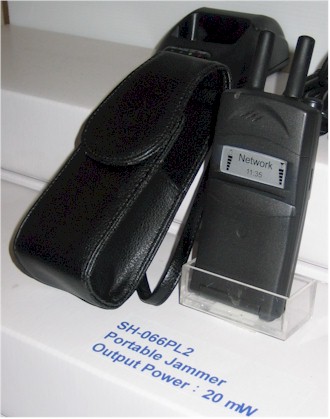
A discreet cellular jammer
This little baby could be the perfect solution the next time you’re stuck in a restaurant with people that just won’t hang up and eat!

